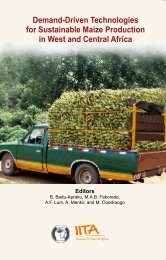Impact of cowpea breeding and storage research in Cameroon - IITA
Impact of cowpea breeding and storage research in Cameroon - IITA
Impact of cowpea breeding and storage research in Cameroon - IITA
Create successful ePaper yourself
Turn your PDF publications into a flip-book with our unique Google optimized e-Paper software.
Cowpea postharvest <strong>and</strong> socioeconomic studies<br />
not <strong>in</strong>clude <strong>in</strong>secticide or heat<strong>in</strong>g treatments, <strong>in</strong>secticide loss <strong>and</strong> heat<strong>in</strong>g are measured by<br />
data on the solar dis<strong>in</strong>festations (4% after six months). Hermetic <strong>storage</strong> loss is estimated<br />
with data from the triple bagg<strong>in</strong>g treatment (4% after six months).<br />
Each <strong>of</strong> these loss estimates assumes that <strong>cowpea</strong> put <strong>in</strong>to <strong>storage</strong> has an <strong>in</strong>itial damage<br />
level like that <strong>of</strong> Vya after three months on a danki <strong>in</strong> pod form (4.3%). Vya is typical <strong>of</strong><br />
many local <strong>cowpea</strong> varieties that are not particularly resistant to bruchids <strong>in</strong> pod form.<br />
While it is clear that the actual <strong>storage</strong> situation is much more complicated than this<br />
set <strong>of</strong> simple categories <strong>and</strong> loss rates, it is argued that the weighted average loss (52%)<br />
is a reasonable estimate. Insecticides <strong>and</strong> ash are not always used correctly <strong>and</strong> higher<br />
losses may result. In particular, a lower proportion <strong>of</strong> ash may be used (<strong>of</strong>ten because<br />
<strong>of</strong> a lack <strong>of</strong> an adequate quantity <strong>of</strong> ash) or the second <strong>in</strong>secticide treatment after three<br />
months may be omitted. Some <strong>Cameroon</strong>ian botanicals may reduce <strong>storage</strong> losses, even<br />
though that has not yet been proven <strong>in</strong> the laboratory. Thus, ash <strong>and</strong> <strong>in</strong>secticide losses may<br />
be somewhat higher than estimated <strong>and</strong> the herbs <strong>and</strong> “noth<strong>in</strong>g” category losses may be<br />
lower, but these <strong>of</strong>fset each other.<br />
If the basel<strong>in</strong>e loss parameter (δ) is 52%, the model loss parameter (φ) is 2.09. The loss<br />
reduction for solar heat<strong>in</strong>g (α) is 1.04 (φ) –1/(1–0.043)).<br />
Pod resistance is a characteristic <strong>of</strong> the newly developed varieties Lori Niébé <strong>and</strong> CRSP<br />
Niébé. This would affect the damage that occurs before the <strong>cowpea</strong>s are threshed. For the<br />
model, on-farm trial data with BR1 <strong>and</strong> BR2 were used. After three months on a danki<br />
these varieties showed only 0.8% damage, compared to the 4.3% with Vya. The 0.8%<br />
was then used as the start<strong>in</strong>g damage <strong>in</strong> the six-month <strong>storage</strong> estimates. This is done by<br />
recalibrat<strong>in</strong>g the logistic function used to estimate losses to pass through an <strong>in</strong>itial level<br />
<strong>of</strong> 0.8%, <strong>in</strong>stead <strong>of</strong> 4.3%. With the 0.8% <strong>in</strong>itial damage, the weighted average loss (δ) is<br />
50% <strong>and</strong> an alpha parameter (α = 0.10) is 10%.<br />
Storage costs<br />
Storage costs were estimated based on data provided by Lowenberg-DeBoer (1994). All<br />
technologies except ash <strong>and</strong> triple bagg<strong>in</strong>g were assumed to store gra<strong>in</strong> <strong>in</strong> woven sacks,<br />
valued at 250 FCFA for those that can hold 80 kg. Ash is stored <strong>in</strong> large clay pots called<br />
cannari commonly used to hold water <strong>in</strong> northern <strong>Cameroon</strong>. New pots are valued at<br />
1500 FCFA <strong>and</strong> can hold about 50 kg <strong>of</strong> <strong>cowpea</strong> when mixed 50/50 with ash. They are<br />
assumed to last for five years. Plastic bags are valued at 150 FCFA/bag <strong>and</strong> are assumed<br />
to be used for one season because <strong>of</strong> the risk that reused bags may have small holes.<br />
Insecticide is valued at 175 FCFA/packet with one packet treat<strong>in</strong>g 80 kg seed every three<br />
months. The solar heater is composed <strong>of</strong> two sheets <strong>of</strong> plastic, one clear the other black,<br />
valued at 3500 FCFA <strong>and</strong> given a useful life <strong>of</strong> two years. The estimate used the high<br />
volume estimate outl<strong>in</strong>ed by Lowenberg-DeBoer <strong>in</strong> which 4000 kg seed are treated per<br />
year per solar heater. For lack <strong>of</strong> data, labor is assumed to be the same for all technologies<br />
at 100 FCFA/hour.<br />
The <strong>in</strong>terest cost on the durable <strong>in</strong>vestment is annual, while the <strong>in</strong>terest on variable<br />
cost <strong>in</strong> the model (r) is semiannual.<br />
Us<strong>in</strong>g the estimates, the <strong>in</strong>itial nom<strong>in</strong>al cost <strong>of</strong> <strong>storage</strong> is 6049 FCFA/t or 7117 <strong>in</strong> 1998<br />
FCFA. The nom<strong>in</strong>al cost for the solar heater is 4166 FCFA/t or 4902 <strong>in</strong> 1998 FCFA. Thus<br />
the <strong>storage</strong> cost reduction is estimated at 2215 FCFA <strong>in</strong> 1998 FCFA.<br />
416
















